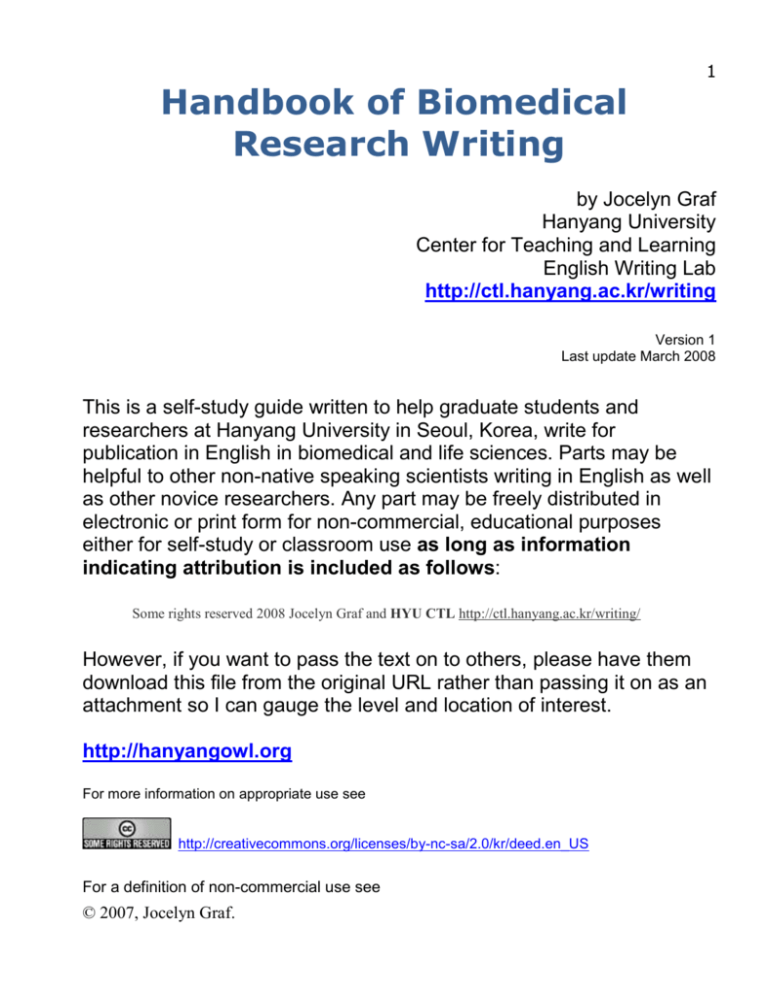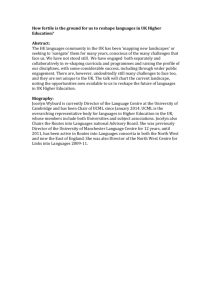
Handbook of Biomedical
Research Writing
1
by Jocelyn Graf
Hanyang University
Center for Teaching and Learning
English Writing Lab
http://ctl.hanyang.ac.kr/writing
Version 1
Last update March 2008
This is a self-study guide written to help graduate students and
researchers at Hanyang University in Seoul, Korea, write for
publication in English in biomedical and life sciences. Parts may be
helpful to other non-native speaking scientists writing in English as well
as other novice researchers. Any part may be freely distributed in
electronic or print form for non-commercial, educational purposes
either for self-study or classroom use as long as information
indicating attribution is included as follows:
Some rights reserved 2008 Jocelyn Graf and HYU CTL http://ctl.hanyang.ac.kr/writing/
However, if you want to pass the text on to others, please have them
download this file from the original URL rather than passing it on as an
attachment so I can gauge the level and location of interest.
http://hanyangowl.org
For more information on appropriate use see
http://creativecommons.org/licenses/by-nc-sa/2.0/kr/deed.en_US
For a definition of non-commercial use see
© 2007, Jocelyn Graf.
2
http://ocw.mit.edu/OcwWeb/web/terms/terms/index.htm#noncomm
This edition is currently being revised. The author welcomes suggestions or corrections at
jocelyngraf@gmail.com .
© 2007, Jocelyn Graf.
1.0 Introduction to Biomedical Research Writing
This handbook is designed for biomedical scientists and healthcare professionals who need to
publish their research in English. It surveys the structure of each section of clinical and basic
biomedical science journal articles and texts for correspondence with journal editors.
1.1 Types of Biomedical Texts
The following tables list the most common biomedical research texts. They indicate where to get
more information about writing each type of text in this book or other sources.
1.1.1 Published Texts
Published texts include all kinds of material found in journals and at conferences.
Full-length journal articles
Research articles with the traditional IMRD structure are
covered in chapters 2-5.
Shorter research reports
Shorter articles follow the same structure as full-length ones.
They have different names in different journals: “letters,”
“reports,” “brief communications,” etc. There is no rule for the
length of full-length vs. shorter papers. The short papers in one
journal may be equal in length to the longer papers in another
journal.
Review
A review does not report on new research. Instead, it surveys a
group of articles on one topic and provides a summary and
analysis of the topic.
Case reports
A case report tells the story of a rare clinical diagnosis or
treatment. See chapter 7.
Case reviews
Case reviews survey a large number of clinical cases.
Critiques of other articles
When authors make an error in published journal texts, another
author can provide a short critique in the following issue of the
journal. These are often called “letters to the editor.”
Other journal content
Journals and professional newsletters accept all kinds of other
short articles: opinions, news reports, policy recommendations,
even photos and video.
Posters
Posters have become another version of the shorter research
report or conference proceedings. See chapters 2-5 for general
information about writing up your research.
Presentation Slides
Creating well-designed and well-written slides with PowerPoint
© 2007, Jocelyn Graf.
3
4
or other software is challenging. See this website for some good
tips: http://writing.engr.psu.edu/slides.html .
Theses and dissertations
When students must write a research paper to graduate with a
Master’s or doctoral degree, the requirements are usually similar
to writing one or more journal articles. One major difference is
that students are expected to provide more background
information, such as definitions of key terms, and survey the
literature more thoroughly in order to prove knowledge of the
field. However, most of the content of chapters 2-5 should be
applicable to dissertation writing. In addition, there are many
books on the market that cover theses and dissertations in more
detail.
1.1.2 “Hidden” Texts
These texts are “hidden” because they are not published and it is sometimes difficult to find good
examples.
Submission letters
When sending a text to a journal for publication, this letter or
email provides basic information to the journal editors. See
chapter 8.
Reviewer comments
Senior scholars write comments when they review articles for
journal publication.
Response to reviewers
The article other must then respond to the reviewer’s comments.
See chapter 8.
Conference proposals
In the sciences, conference proposals (written before
acceptance) and conference abstracts (often written after
acceptance) have much in common with journal article abstracts
and short journal articles. For more details, refer to chapter 5 on
abstracts.
Application letters and
resumes/CVs
Writing cover letters and CVs for job and school applications is a
common challenge. However, they are not covered in this book
because there are a number of excellent online sources of
advice and examples. See the Chronicle of Higher Education CV
Doctor articles, for example:
http://chronicle.com/jobs/tools/cvdoctor/2007/
Other professional
correspondence
Every scientist or healthcare professional must write other kinds
of formal email, such as recommendations and requests for
recommendation. There are also lab equipment and supply
ordering, requests to other scholars to share data or specimens,
grant applications, and correspondence with government
© 2007, Jocelyn Graf.
5
agencies. Follow the general letter and email writing guidelines
in chapter 8.
1.2 The Parts of a Journal Article
A traditional journal article in the sciences consists of four parts: Introduction, Methods, Results, and
Discussion/Conclusion (IMRD). One way to approach these sections is to consider the purpose of
each. Here are the questions you should try to answer in the abstract and again in more detail in the
rest of the article:
Why do we care about the problem and the results?
What problem are you trying to solve?
How did you go about solving or making progress on the problem?
What’s the answer?
What are the implications of your answer?
General
Introduction
Purpose
Specific
General
© 2007, Jocelyn Graf.
Introduction: establishes the
background of the paper, the
nature of the research
problem, the importance of the
topic, or the newness of the
research.
Purpose: indicates purpose,
thesis or hypothesis, outlines
the intention behind the paper.
Methods
Methods: provides information
on design, procedures,
assumptions, approach, data,
etc.
Results
Results (Product): states main
findings or results, the argument, or
what was accomplished.
Discussion/
Conclusion
Discussion/Conclusion: interprets
or extends results beyond scope or
paper, draws inferences, points to
applications or wider implications or
recommendations








